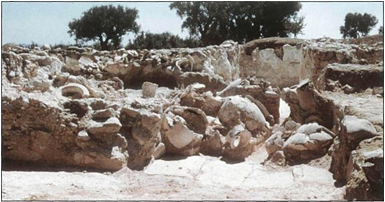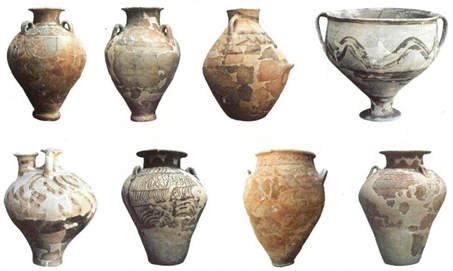Main Buliding
Some four or five courses higher there was probably another beam of the same kind, running along the length of the wall. If there were window openings, the existence of which is uncertain, the lower beam could have served as a sill and the upper beam as the lintel. Just to the northwest, beyond the court, there is a rather broad recess or niche in the wall, probably designed for aesthetic reasons; perhaps it contained a window. Outside the wall, farther northwestward, a large spread of squared blocks that fell from the wall has been left just as it was found. Looking from the court one can distinguish five or six rows of these stones, each probably representing a course. It is clear that a large section of the wall fell outward in one piece as a unitwhen the fire that consumed the palace was at its height. The olive oil stored in storeroom 32 may well have burst into flame with explosive violence.

Regaining the lobby (38) we may pause to note that it was found filled with the crushed wreckage of some twenty or more large storage jars (pithoi) and many smaller pots (Figs. 16,17). The pithoi had contained olive oil and had for the most part fallen from the upper floor; their flammable contents clearly roused the flames to destructive fury.

Scattered about in the burned debris were found nineteen fragments of inscribed tablets, which deal with olive oil of various kinds and for various purposes.
Passing southeastward through a doorway one enters a long, narrow bathroom (43), the only one of its kind yet found in a Mycenaean palace on the Greek mainland with its equipment still fairly well preserved. A terracotta bathtub (larnax) stands against the southeastern wall of the room. It is decorated with painted patterns, and set into a stucco-coated base made of clay. The tub is rather short; the bather presumably sat in it while a servant or atten¬dant poured water over him.12 A convenient step of clay, coated with stucco, made it easy to step from the floor into the bath. In the southern corner of the room, on the same side as the bath, is a tall stand also made of clay coated with plaster. In it were set two large storage jars (pithoi) some 1.20 m (4 feet) high, which probably contained the water needed for the bath. In the bottom of the southwest¬ern pithos were found seven, and in that of the other jar nine, plain drinking cups, along with a few other small pots. One complete drinking cup was discovered on the bottom of the bath itself. These vessels were no doubt used for pouring water over the bather.